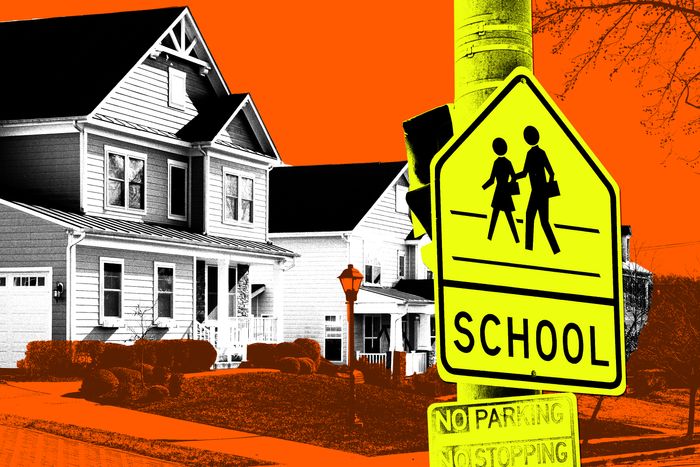Meet Sean O’Dowd, Who’s Buying Homes in Top School Districts


Photo-Illustration: Curbed; Photos: Getty
Fair-housing laws prevent real-estate brokers from boasting about school districts — they can say, for example, that a Park Slope apartment is in P.S. 321, but not that the school has some of the most coveted kindergarten seats in Brooklyn. Of course, parents know exactly what it means to be zoned for P.S. 321. Even buyers without kids know what it means, because living in a sought-after school district is as real a resale advantage as an extra bathroom or a terrace. In New York, families can always rent in the city’s most desirable school districts — rents are often higher, but at least there’s an option of paying up for a few years or cramming into a small apartment. In most of the country, though, the only way to attend a top public school is to buy in the right area. The demand is there, but the rentals aren’t.
It’s a market dynamic that a Chicago-based real-estate investor named Sean O’Dowd is banking on. O’Dowd, who launched a fund last year, even named his fund accordingly: Scholastic Capital. Over the next ten years, the fund plans to buy 250 single-family homes in 21 different midwestern Zip Codes with top-performing schools and list them as rentals. “People are running the buy-versus-rent math and they’re looking at it as, ‘I’m going to be in this area for four years, then my kid is out of the house. That’s all I need it for,’” O’Dowd says.
While institutional investors like hedge funds and private-equity firms are staking a larger presence in the single-family housing market, most tend to buy in less expensive neighborhoods, where their all-cash purchases may edge out first-time homebuyers, not in tony enclaves with million-dollar homes. O’Dowd’s play is a savvy one, albeit one that feeds off the American obsession with educational pedigree, which often results in neighborhoods and regions sharply divided along lines of class and race. The Midwest, in particular, has some of the highest rates of segregation in its schools and cities.
There’s also a reason that institutional investors haven’t come for Greenwich yet: It’s trickier to make the math work on single-family rentals in wealthy enclaves. Not only is the purchase price higher, but property taxes can run upward of $20,000 a year in fancy suburbs with top-tier schools. To avoid the cost of carrying empty homes, O’Dowd says the fund will only buy in late spring and summer, when families move for the upcoming school year. Costs are also lower in the Midwest than on the coasts, and the four homes that the fund bought for a trial run attracted multiple rental applications from families with six-digit incomes.
“One of the tenants literally broke down in tears,” he says. “It was one of the only rental homes she’d seen in the last 18 months because they’re never available in that community and she really wanted to send her kids to that school.”
O’Dowd says that in one of the Zip Codes where they’re planning to buy, a town that is among the wealthiest in Illinois — he asked that we not name it, citing his competitors — homes run around a million dollars. That’s a jumbo mortgage, which would require a 25 percent, or $250,000, down payment. A lot of middle- and upper-middle-class families, even if they’re pulling in $200,000 a year, don’t have that kind of scratch lying around. They may, however, be able to pay $3,500 a month for a rental, which O’Dowd says would be around what the homes will go for, with variations based on the property itself and the local market.
But even more renters, he says, have the money to buy and prefer not to — partially because of the astronomical property taxes, and also because the process of buying and selling a home is a hassle and not necessarily profitable if you only want to own for a few years. It’s a weird corner of the market where investor-owned single-family homes might create more affordable housing options in upscale towns, opening up elite school districts to the merely upper-middle class. Many of O’Dowd’s investors are also interested in keeping the houses as rentals rather than cashing out in ten years, so they can continue to draw income without the hassle of being landlords themselves.
The fund is particular about what it wants — at least three bedrooms and 1.5 baths, streets where the speed limit doesn’t exceed 25 miles per hour and, of course, the kinds of schools that parents talk about reverentially. That means excellent test scores, rankings, and admissions to the right kinds of colleges. O’Dowd says that of the 1,926 homes for sale in the 21 Zip Codes the fund is focusing on, only 46 meet their criteria (pools, for example, are a no-go, for insurance, maintenance, and resale purposes).
At the moment, he has no plans to expand the fund to other areas — buying in the New York suburbs right now is still a bloodsport (about half of all homes there are still subject to bidding wars, thanks to anemic inventory). And California, Florida, and Texas have such high insurance rates that it’s a nonstarter. “But it works here — there is a customer who is looking for this kind of product in the Midwest,” he says. Many parents don’t realize just how much they value going to a top school — and that it’s something they’d pay premium real-estate prices for — until their kids are approaching high school.
The fund’s assessment of what makes a good school isn’t just based on some algorithm. O’Dowd says the perception of good schools is also important. Some districts just don’t get parents excited, even if the schools themselves are excellent. The fund is not, for example, planning to buy in Evanston, an upscale suburb just north of Chicago, despite a high school that sends many of its graduates to the Ivies and top midwestern colleges. It’s good on paper, but he doesn’t think it’s perceived as “elite.” How does he determine that? He and his partner do most of the reconnaissance work themselves. “We’ve spent a lot of time in parks and playgrounds.”
link




